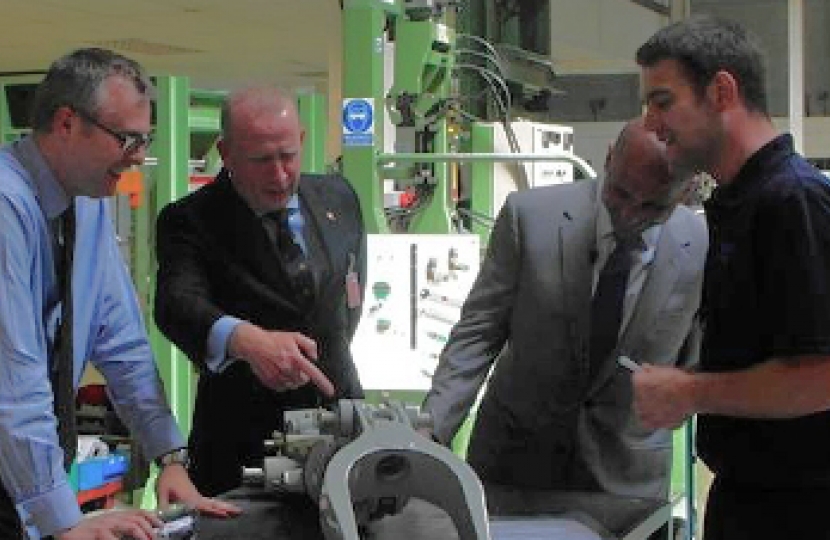
Graham Evans: It is a pleasure to speak under your chairmanship, Dr McCrea. I add my congratulations to my hon. Friend the Member for Carlisle (John Stevenson).
I am deeply proud of Weaver Vale’s huge range of manufacturing enterprises. I personally spent more than 20 years working in manufacturing, starting off at BAE Systems making RAF Nimrods. I am delighted that EEF has announced that the domestic market is at its strongest in almost three years and export sales are at a two-year high. That marks a significant growth in confidence and provides some reassurance that the industry is on the right track. However, although that shows a short-term improvement, it is set against the long-term trend that has seen manufacturing’s share of the economy fall from 23% in 1997 to about 10% currently. That sits alongside the Government’s ambitious target to double UK exports to £1 trillion by 2020—manufacturing currently makes up about half the market. I would be interested to hear my hon. Friend the Minister’s opinion on that and whether he thinks that this country could once again have 20-odd per cent. of its GDP based on manufacturing.
How do SMEs fit into that pattern of ambition and decline? In 2012, SMEs—defined as companies with fewer than 250 employees—made up 99% of all manufacturing businesses, with a turnover of £167,455 million, less than a third of the whole industry’s turnover. However, not all SMEs are created equal. Clearly, the needs and capacity of a 249-employee company are very different from those of a nine-employee company. In 2012, there were 203,000 manufacturing business with nought to nine employees, which made up 88% of manufacturing businesses and 96% of all businesses in the UK.
What can we proactively do to support SMEs? There are two clear lines of support which could and should be better developed. Research and development is key to the UK’s manufacturing future. Manufacturing is responsible for three quarters of business R and D. That is a staggering amount and a credit to our world-leading universities and work ethic. The flexibility, adaptability and innovation of SMEs make them perfect leaders of R and D. To ensure our place in the world market, we need to be able to provide financial, research and trade support to SMEs at this crucial time.
First, we should consider finance. Simply put, without strong, reliable and consistent funding, we cannot expect SMEs to grow and thrive. There are some strong incentives to help SMEs involved in R and D. From April 2012, the tax relief for SMEs is 225%. For every £100 of qualifying costs, corporation tax is not paid on an additional £125 income that would be liable for corporation tax. It is worth noting that HMRC has extended its definition of an SME to companies of under 500 employees.
I have spoken previously in the House about the German political infrastructures set up to nurture industry and especially the Mittelstand—small and medium-sized companies. Foremost among those tools stands KfW, the state-backed bank that ensures that the Mittelstand can access funding, even when the commercial banks are unwilling to lend.
Certainly Government schemes such as the advanced manufacturing supply chain initiative and the high-value manufacturing Catapult, which is designed to bridge the gap between early-stage innovation and manufacturing, are helpful, but they do not address the industry’s concerns about simple access to finance. The right hon. Member for Sheffield, Brightside and Hillsborough (Mr Blunkett) ably pointed that out earlier.
Secondly, with 71% of manufacturers planning innovation to export to new markets and 73% planning to bring new products to the market, they require not only funding but research collaboration. I welcome the work of the Technology Strategy Board’s Catapult network on high-value manufacturing, which brings together SMEs and industrial investors to work together on the centre’s core research and on their own challenges and the knowledge transfer partnership. That form of business/research collaboration speeds up innovation. It is a credit to the Government that 62%—up from 44% in 2010—of manufacturing companies are now engaged in work with research institutions. I have seen that in action at the excellent Daresbury science and innovation campus in my constituency.
Once development has been completed, UKTI must take the innovations and provide a clear and supported route to market. I welcome the £70 million increase for UKTI and I believe that it is the role of those in this House to push the manufacturing agenda to the forefront of campaigns such as the GREAT campaign to demonstrate our unique and innovative industry to key and emerging markets.
It is clear that we need a blueprint for the long-term future of the manufacturing industry and especially SMEs that goes beyond general commitments to industry as a whole. That is why we are all waiting with bated breath for the report of the Future of Manufacturing project, which will set out the long-term future of the manufacturing sector to 2050. It is due in the next few months. I sincerely hope that much of what has been discussed today will feed in to that report in order to help to ensure that the powerhouse that is SMEs in the manufacturing industry is properly supported.
